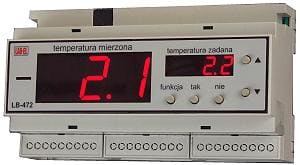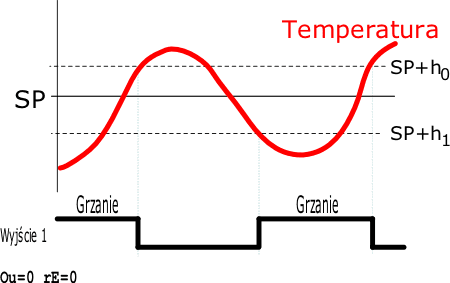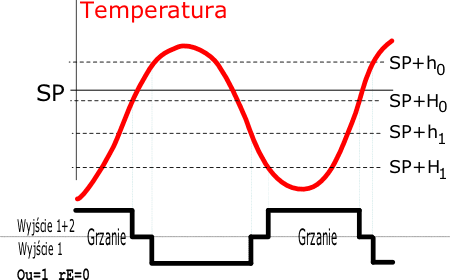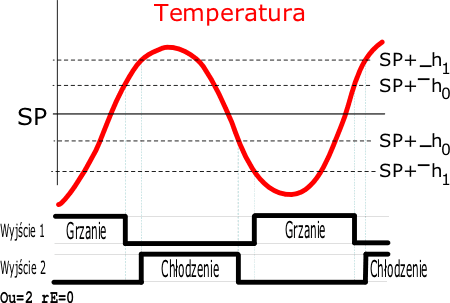- two channel regulator
- two channel thermometer, psychrometer
- big, easy to read display
- interface RS-232C and S300
- controlling 4 devices
- exceed signaling

|
 |
Regulator LB-474C is an integrated device, which realizes temperature measurement function at two points and control over the executive devices allowing on maintaining specific climate parameters. The device can be used as a meter and a regulator of temperature and humidity, after being attached to a psychrometer in a place provided for the temperature probes. A controller allows on defining two regulation trajectories with two executive devices for each trajectory that are switched on of off by LB-474C in specified by a user conditions.
The device allows on defining the threshold values of the measured values and by using an alarm output signals the situations, where a value exceeds an acceptable interval.
The regulator has a big, easy to read LED display (digit height 25mm and 10mm), which presents a measured temperature value (on a big display) and another temperature or humidity (on a smaller display). The measurement results are available to be read through a series port RS-232C as well as through a port S300 that works as a digital current loop.
The device performs measurement of two temperatures using the outside sensors with the platinum thermo resistors Pt-1000 (or optionally Pt-100). Applying of the platinum thermo resistors assures high measurement accuracy and constancy of thermometer characteristics. The outside temperature sensors are made in the casings adjusted in construction to the individual requirements. Various types of sensor casings allow on measurement of different media in various scopes of temperature. Two thermometers can also make a psychrometer (working based on a principle of a dry and wet bulb thermometer), what allows on independent measurement and regulation of air temperature and humidity. The temperature sensors are attached to the regulator using clamps.
The temperature measurement trajectory is calibrated by a producer
and the calibration data is stored in a panel in a digital form. The
controller does not have any mechanical calibration elements (i.e.
potentiometers). The calibration of the device is performed by sending
calibration data obtained in the model climate conditions through a
digital interface to the non-volatile memory of the device. It
guarantees comfort and high calibration accuracy as well as stability
of the device's meteorological parameters in time.
The regulator LB-474 has five control outputs with outputs with the transistor keys, assigned for controlling the outside transmitters (i.e. in a form of an outside unit of transmitters LB-475).
The device is designed to be used in the stationary conditions and its casing has clamps allowing on assembly on a standard bus rail TS35. The device is powered from the energy network 230V.
The regulator with the temperature sensors, adequately to an order, can have an individual calibration certificate of temperature and humidity measurement trajectory from the LAB-EL Calibration Laboratory.
 |
 |
 |
| Rys. 1 |
Rys. 2 |
Rys. 3 |
The simplest control mode is based on controlling one executive device, which is switched on when a measured parameter drops below a certain threshold value and switched off if it goes beyond an accepted value. Picture no. 1 shows an example of temperature regulation using a heater as an executive device: heating is switched on below temperature SP+h1 and switched off above temperature SP+h0. It is possible to reverse the control logic and attach a cooling device.
The second control mode allows on two stage control over one executive device or two separate devices of the same character. Example on picture no. 2 illustrates a situation of controlling an object’s temperature in this more. Below temperature SP+H1 both degrees of power are switched on and work until temperature reaches a level SP+H0, after that heating power is reduced. A total switch off is performed after reaching SP+h0. After temperature drops to a level SP+h1 one degree is switched on and if temperature still drops then the other one is still switched on with SP+H1. Similarly like for the previous mode it is possible to reverse the control logic and supervise i.e. two cooling units.
The third mode allows on controlling a parameter using two executive devices, where one increases and the other one diminishes value of the measured parameter. Picture no. 3 shows an example of controlling temperature using the heating and cooling devices. A user defines switch on and off thresholds separately for each one of the devices.
| MEASUREMENT READINGS |
||
|---|---|---|
| Parameter | Scope of reading | Resolution displayed |
| Temperature | -99,9..+99,9°C | 0,1°C |
| +100..+259°C | 1°C | |
| Humidity |
5..99,9% |
0.1% |
| MEASUREMENT UNCERTAINTY |
||
|---|---|---|
| Parameter | Scope of reading | Uncertainty |
| Temperature | -40..150°C | 0,1°C +/- last digit |
| -99,9..+259°C | 1°C +/- last digit |
|
| Humidity |
0..15 |
2% +/- last digit |
| 15..50% |
1,5% +/- last digit | |
| 50..99,9% |
1% +/- last digit | |
| POWER SUPPLY, CONTROL OUTPUT | |
|---|---|
| network power supply | 230V 50 Hz |
| energy consumption |
5 VA |
| control outputs fan-out (open
collector LB-474C) |
40V, 500 mA, DC |
| control outputs fan-out (a block of transmitters LB-475) | 230V, 6A, AC/DC |
| type of fan-out | resistance or a transmitter coil |
| SCOPE OF WORK TEMPERATURES | ||
|---|---|---|
| Device | Scope | Comments |
| Regulator LB-474C | 0..+50°C | |
| Temperature sensor | -60..+90°C | basic scope, limited additionally by a temperature sensor's
construction |
| -150..+259°C | extended scope, limited additionally by a temperature sensor's
construction |
|
| RECOMMENDED CONSTANT WORK CONDITIONS LB-472 | |
|---|---|
| Scope of temperatures | 10..40°C |
| Scope of humidity | 20..80% |
| Level of environment corrosion aggressiveness according to PN-71/H-04651 | B |
| Class of resistance according to DIN40050 | IP40 |